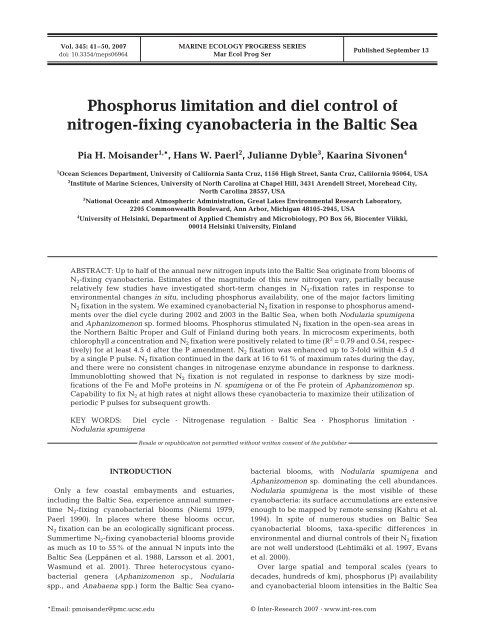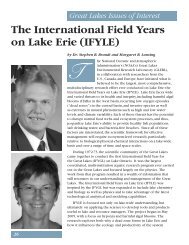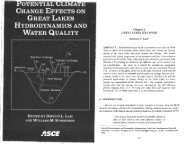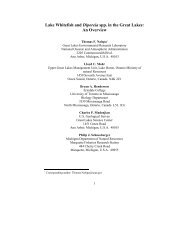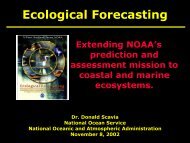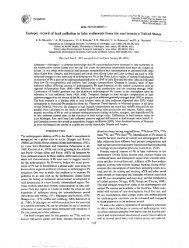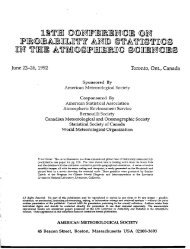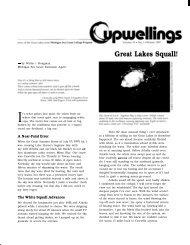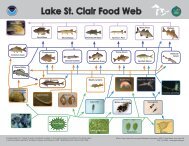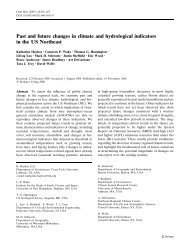Phosphorus limitation and diel control of nitrogen-fixing ...
Phosphorus limitation and diel control of nitrogen-fixing ...
Phosphorus limitation and diel control of nitrogen-fixing ...
You also want an ePaper? Increase the reach of your titles
YUMPU automatically turns print PDFs into web optimized ePapers that Google loves.
Vol. 345: 41–50, 2007<br />
doi: 10.3354/meps06964<br />
MARINE ECOLOGY PROGRESS SERIES<br />
Mar Ecol Prog Ser<br />
Published September 13<br />
<strong>Phosphorus</strong> <strong>limitation</strong> <strong>and</strong> <strong>diel</strong> <strong>control</strong> <strong>of</strong><br />
<strong>nitrogen</strong>-<strong>fixing</strong> cyanobacteria in the Baltic Sea<br />
Pia H. Mois<strong>and</strong>er 1, *, Hans W. Paerl 2 , Julianne Dyble 3 , Kaarina Sivonen 4<br />
1 Ocean Sciences Department, University <strong>of</strong> California Santa Cruz, 1156 High Street, Santa Cruz, California 95064, USA<br />
2 Institute <strong>of</strong> Marine Sciences, University <strong>of</strong> North Carolina at Chapel Hill, 3431 Arendell Street, Morehead City,<br />
North Carolina 28557, USA<br />
3 National Oceanic <strong>and</strong> Atmospheric Administration, Great Lakes Environmental Research Laboratory,<br />
2205 Commonwealth Boulevard, Ann Arbor, Michigan 48105-2945, USA<br />
4 University <strong>of</strong> Helsinki, Department <strong>of</strong> Applied Chemistry <strong>and</strong> Microbiology, PO Box 56, Biocenter Viikki,<br />
00014 Helsinki University, Finl<strong>and</strong><br />
ABSTRACT: Up to half <strong>of</strong> the annual new <strong>nitrogen</strong> inputs into the Baltic Sea originate from blooms <strong>of</strong><br />
N 2 -<strong>fixing</strong> cyanobacteria. Estimates <strong>of</strong> the magnitude <strong>of</strong> this new <strong>nitrogen</strong> vary, partially because<br />
relatively few studies have investigated short-term changes in N 2 -fixation rates in response to<br />
environmental changes in situ, including phosphorus availability, one <strong>of</strong> the major factors limiting<br />
N 2 fixation in the system. We examined cyanobacterial N 2 fixation in response to phosphorus amendments<br />
over the <strong>diel</strong> cycle during 2002 <strong>and</strong> 2003 in the Baltic Sea, when both Nodularia spumigena<br />
<strong>and</strong> Aphanizomenon sp. formed blooms. <strong>Phosphorus</strong> stimulated N 2 fixation in the open-sea areas in<br />
the Northern Baltic Proper <strong>and</strong> Gulf <strong>of</strong> Finl<strong>and</strong> during both years. In microcosm experiments, both<br />
chlorophyll a concentration <strong>and</strong> N 2 fixation were positively related to time (R 2 = 0.79 <strong>and</strong> 0.54, respectively)<br />
for at least 4.5 d after the P amendment. N 2 fixation was enhanced up to 3-fold within 4.5 d<br />
by a single P pulse. N 2 fixation continued in the dark at 16 to 61% <strong>of</strong> maximum rates during the day,<br />
<strong>and</strong> there were no consistent changes in <strong>nitrogen</strong>ase enzyme abundance in response to darkness.<br />
Immunoblotting showed that N 2 fixation is not regulated in response to darkness by size modifications<br />
<strong>of</strong> the Fe <strong>and</strong> MoFe proteins in N. spumigena or <strong>of</strong> the Fe protein <strong>of</strong> Aphanizomenon sp.<br />
Capability to fix N 2 at high rates at night allows these cyanobacteria to maximize their utilization <strong>of</strong><br />
periodic P pulses for subsequent growth.<br />
KEY WORDS: Diel cycle · Nitrogenase regulation · Baltic Sea · <strong>Phosphorus</strong> <strong>limitation</strong> ·<br />
Nodularia spumigena<br />
Resale or republication not permitted without written consent <strong>of</strong> the publisher<br />
INTRODUCTION<br />
Only a few coastal embayments <strong>and</strong> estuaries,<br />
including the Baltic Sea, experience annual summertime<br />
N 2 -<strong>fixing</strong> cyanobacterial blooms (Niemi 1979,<br />
Paerl 1990). In places where these blooms occur,<br />
N 2 fixation can be an ecologically significant process.<br />
Summertime N 2 -<strong>fixing</strong> cyanobacterial blooms provide<br />
as much as 10 to 55% <strong>of</strong> the annual N inputs into the<br />
Baltic Sea (Leppänen et al. 1988, Larsson et al. 2001,<br />
Wasmund et al. 2001). Three heterocystous cyanobacterial<br />
genera (Aphanizomenon sp., Nodularia<br />
spp., <strong>and</strong> Anabaena spp.) form the Baltic Sea cyanobacterial<br />
blooms, with Nodularia spumigena <strong>and</strong><br />
Aphanizomenon sp. dominating the cell abundances.<br />
Nodularia spumigena is the most visible <strong>of</strong> these<br />
cyanobacteria: its surface accumulations are extensive<br />
enough to be mapped by remote sensing (Kahru et al.<br />
1994). In spite <strong>of</strong> numerous studies on Baltic Sea<br />
cyanobacterial blooms, taxa-specific differences in<br />
environmental <strong>and</strong> diurnal <strong>control</strong>s <strong>of</strong> their N 2 fixation<br />
are not well understood (Lehtimäki et al. 1997, Evans<br />
et al. 2000).<br />
Over large spatial <strong>and</strong> temporal scales (years to<br />
decades, hundreds <strong>of</strong> km), phosphorus (P) availability<br />
<strong>and</strong> cyanobacterial bloom intensities in the Baltic Sea<br />
*Email: pmois<strong>and</strong>er@pmc.ucsc.edu<br />
© Inter-Research 2007 · www.int-res.com
42<br />
Mar Ecol Prog Ser 345: 41–50, 2007<br />
are closely linked with bottom-water redox conditions<br />
(Kiirikki et al. 2001). Over long periods <strong>of</strong> stagnation,<br />
oxygen in waters beneath the Baltic Sea halocline is<br />
consumed <strong>and</strong> anoxia develops (Nehring 1981). Under<br />
anoxic conditions, phosphate <strong>and</strong> ammonia are<br />
released, while in hypoxic waters <strong>and</strong> sediments,<br />
denitrification is promoted (Kuparinen & Tuominen<br />
2001). Both <strong>of</strong> these processes promote reductions in<br />
the N:P ratio in dissolved nutrients in the bottom<br />
waters. Baltic Sea bottom-water exchange is dependent<br />
on frequency <strong>of</strong> storms that force salty oceanic<br />
water over the sills at the Danish Sounds to the Baltic<br />
Sea from the North Sea. As this salty water oxygenates<br />
the Baltic Sea bottom, some <strong>of</strong> the lower salinity, low<br />
N:P ratio, P-enriched anoxic bottom waters are transported<br />
to the surface (Nehring 1981) <strong>and</strong>, as a result,<br />
intense cyanobacterial blooms develop over the next<br />
several years (Kahru et al. 2000, Kiirikki et al. 2001).<br />
Superimposed on this large-scale forcing cycle,<br />
which has significant interannual variability in the<br />
Baltic Sea, P effects on growth <strong>and</strong> N 2 fixation <strong>of</strong><br />
cyanobacteria are observed regionally <strong>and</strong> locally, at<br />
short time scales. Certain Baltic Sea regions are hydrodynamically<br />
more active than others, <strong>and</strong> susceptible<br />
to vertical water exchange such as upwelling <strong>and</strong><br />
frontal transport that act as ‘P pumps’ into the surface<br />
waters (Kononen et al. 1996, Pavelson et al. 1997,<br />
Vahtera et al. 2005). These locations are <strong>of</strong>ten sites <strong>of</strong><br />
intensive cyanobacterial growth. Cyanobacterial populations<br />
in the euphotic surface waters are likely to<br />
experience P depletion repeatedly over the growing<br />
season, depending on hydrodynamic conditions <strong>and</strong><br />
how far they have advected from these P ‘hotspots’. P<br />
regeneration within Nodularia spumigena aggregates<br />
may be an important mechanism by which blooms are<br />
maintained (Hagström et al. 2001). There is a general<br />
agreement that P regulates cyanobacterial bloom<br />
intensities in the Baltic Sea over interannual, basinwide<br />
scales (Kahru et al. 2000, Kiirikki et al. 2001).<br />
However, estimates on the regulation <strong>and</strong> <strong>limitation</strong> <strong>of</strong><br />
cyanobacterial growth <strong>and</strong> N 2 fixation in the Baltic Sea<br />
vary over time scales <strong>of</strong> hours to days (Wallström et al.<br />
1992, Stal et al. 1999, Rydin et al. 2002, Mois<strong>and</strong>er et<br />
al. 2003).<br />
The goal <strong>of</strong> this study was to investigate short-term<br />
effects <strong>of</strong> P on the growth <strong>and</strong> N 2 fixation <strong>of</strong> Baltic Sea<br />
cyanobacteria, to better underst<strong>and</strong> regional differences<br />
in bloom intensities <strong>and</strong> mechanisms for bloom<br />
maintenance. In order to study regulation <strong>of</strong> the <strong>nitrogen</strong>ase<br />
proteins over the <strong>diel</strong> cycle, we additionally<br />
investigated potential changes in the quantity <strong>and</strong> size<br />
<strong>of</strong> the 2 c<strong>of</strong>actors <strong>of</strong> the <strong>nitrogen</strong>ase enzyme (Fe <strong>and</strong><br />
MoFe proteins) in response to darkness. This information<br />
is essential for predicting <strong>and</strong> modeling cyanobacterial<br />
bloom formation <strong>and</strong> N 2 fixation based on<br />
P availability in the Baltic Sea.<br />
MATERIALS AND METHODS<br />
Baltic Sea field studies. Field studies were carried<br />
out onboard RV ‘Ar<strong>and</strong>a’ (Finnish Institute <strong>of</strong> Marine<br />
Research) in 2002 <strong>and</strong> 2003. The study area was<br />
located in the Gulf <strong>of</strong> Finl<strong>and</strong> <strong>and</strong> the Northern Baltic<br />
Proper (Table 1). Diel cycles in the field were studied<br />
through incubation experiments on deck using Baltic<br />
seawater (Expts 02A, 02B, 03A, 03B), <strong>and</strong> by sampling<br />
directly from the sea (Expt An03), both types <strong>of</strong><br />
samples defined as ‘field samples’ (Table 1). In the<br />
incubation experiments, surface water was collected<br />
from ~1 m depth using a pump (in 2002), or a 30 l water<br />
sampler (2003). All <strong>of</strong> the water collected was mixed in<br />
a 100 l container on deck, <strong>and</strong> then 14 l (2002) or 17 l<br />
(2003) were poured into each <strong>of</strong> six 20 l pre-cleaned<br />
(0.01 N HCl <strong>and</strong> deionized water) Cubitainers<br />
(Hedwin). Cubitainers are containers made <strong>of</strong> polyethylene<br />
<strong>and</strong> are approximately 85% transparent to incident<br />
photosynthetically active irradiation (PAR). The<br />
Table 1. Diel experiments with natural communities in the Baltic Sea. Temperature, salinity, <strong>and</strong> nutrients are from 1.5 to 2 m depth<br />
Expt Date Type Station Location Treatment Temp. Salinity DIN DIP<br />
or depth (°C) (µM) (µM)<br />
02A Sampled 15 July 2002 Cubitainer H02_A1_4 59.2946° N, Control, P 18.3 5.6 0.12 a 0.2 a<br />
Expt 16-17 July 2002<br />
23.0215° E<br />
02B Sampled 18 July 2002 Cubitainer H02_EA 59.2210° N, Control, P 20.0 5.6 0.14 0.16<br />
Expt 22-23 July 2002<br />
22.4309° E<br />
03A Sampled 16 July 2003 Cubitainer LL3A 60.0403° N, Control, P 16.7 6.2<br />
Expt 19-20 July 2003<br />
26.2079° E<br />
03B Sampled 14 July 2003 Cubitainer JML 59.3506° N, Control, P 19.3 5.2<br />
Expt 15-16 July 2003<br />
23.3766° E<br />
An03 24-25 July 2003 Rosette JML 59.3506° N, 0 m, 8 m 20.2–21.1 5.4–5.5<br />
23.3766° E<br />
a Determined at 0 m depth
Mois<strong>and</strong>er et al.: <strong>Phosphorus</strong> <strong>and</strong> Baltic Sea <strong>nitrogen</strong> fixation<br />
43<br />
Cubitainers were inoculated with a concentrated phytoplankton<br />
sample, consisting mostly <strong>of</strong> the filamentous<br />
cyanobacteria collected by vertical tows from the<br />
0 to 10 m surface layer using a 100 µm zooplankton net<br />
(2.6 l in 2002 <strong>and</strong> 1 l in 2003). Three Cubitainers<br />
received a phosphorus addition (as K 2 HPO 4 ; 2 µM final<br />
concentration), while the other 3 were <strong>control</strong>s. The<br />
Cubitainers were placed in tubs on the ship deck<br />
under natural irradiance with flowing surface seawater<br />
for temperature <strong>control</strong>. They were shaded with<br />
screening to alleviate photoinhibition by reducing PAR<br />
by 30%. Measurements were started within 16 to 88 h<br />
<strong>of</strong> the P addition. In each experiment, the <strong>diel</strong> measurements<br />
were initiated at 06:00 h. A sub-sample<br />
from the Cubitainers was collected every 3 h over the<br />
<strong>diel</strong> cycle in order to determine the rates <strong>of</strong> N 2 fixation<br />
using the acetylene reduction technique (AR). For<br />
immunoblotting <strong>of</strong> the <strong>nitrogen</strong>ase enzyme, a subsample<br />
was collected every 3 h during the day <strong>and</strong><br />
every 1 to 1.5 h at night. Sub-samples were also preserved<br />
in Lugol’s solution for microscopic observations<br />
<strong>of</strong> community structure.<br />
In addition to the incubation experiments, diurnal<br />
patterns <strong>of</strong> N 2 fixation were assessed in samples collected<br />
directly from the Baltic Sea at each time point <strong>of</strong><br />
the <strong>diel</strong> study. A 24 h anchor station experiment was<br />
conducted on 24-25 July 2003 (Table 1, Expt An03),<br />
during which samples for N 2 -fixation measurements<br />
were collected from 1 m <strong>and</strong> 8 m depths every 3 h with<br />
Niskin bottles. Samples for immunoblotting during this<br />
experiment were collected every 3 h during the day<br />
<strong>and</strong> every 1 h at night for 24 h. Additionally, CTD<br />
pr<strong>of</strong>iles <strong>and</strong> vertical pr<strong>of</strong>iles <strong>of</strong> PAR were obtained on<br />
each sampling occasion.<br />
Culture studies. In order to study <strong>diel</strong> patterns <strong>of</strong><br />
N 2 fixation in Nodularia spumigena in more detail, a<br />
<strong>diel</strong> experiment was carried out in the laboratory with<br />
N. spumigena strain FL2f isolated from the Baltic Sea<br />
(Mois<strong>and</strong>er et al. 2002). The cultures were kept on a<br />
15:9 h light:dark cycle. The experimental cultures<br />
were grown in a 1 l volume in duplicate 2 l flasks with<br />
constant aeration provided through a 0.2 µm filter <strong>and</strong><br />
kept in an incubator at 27 to 30°C <strong>and</strong> 200 µmol m –2 s –1<br />
PAR. The strains were grown in Z8 media (Rippka<br />
1988), with combined <strong>nitrogen</strong> omitted <strong>and</strong> salts<br />
added at 0.15 M NaCl <strong>and</strong> 0.015 M MgSO 4 (final<br />
concentrations) for optimal growth (Mois<strong>and</strong>er et al.<br />
2002). Samples for the following assays were collected<br />
every 2 h during the <strong>diel</strong> experiments: CO 2 fixation<br />
(NaH 14 CO 3 incorporation), N 2 fixation (acetylene reduction<br />
assay), abundance <strong>of</strong> the Fe <strong>and</strong> MoFe<br />
proteins in the <strong>nitrogen</strong>ase enzyme (SDS-PAGE <strong>and</strong><br />
immunoblotting with Fe <strong>and</strong> MoFe protein antibodies),<br />
chlorophyll a (chl a) concentration, <strong>and</strong> dissolved inorganic<br />
carbon (DIC) concentration.<br />
Analytical methods. Acetylene reduction assay<br />
(AR): N 2 -fixation activity was measured every 2 h in<br />
cultures <strong>and</strong> every 3 h in field samples. In the field<br />
studies, 1 AR measurement was taken from each<br />
Cubitainer (triplicate Cubitainers per treatment) or in<br />
triplicate from the Niskin bottle (Expt An03), whereby<br />
a 90 ml sample was incubated in 117 ml serum vials<br />
capped with red rubber serum stoppers. In culture<br />
experiments, duplicate AR measurements were made<br />
from 2 independent culture flasks each, whereby 8 ml<br />
<strong>of</strong> culture was transferred into 13 ml Exetainer tubes<br />
(Labco) <strong>and</strong> tubes were capped with serum screw<br />
caps. Acetylene was generated from calcium carbide,<br />
<strong>and</strong> 9 or 2 ml acetylene was injected with a syringe into<br />
each vial through the liquid phase in field <strong>and</strong> culture<br />
experiments, respectively. Next, the incubation vials<br />
were shaken for ~10 s. AR vials in the field were incubated<br />
for 3 h in the flowing surface water bath on the<br />
deck, while the AR vials in culture experiments were<br />
incubated for 2 h in the culture incubator. At the end <strong>of</strong><br />
the incubation, tubes <strong>and</strong> flasks were shaken for ~20 s,<br />
<strong>and</strong> sub-samples <strong>of</strong> the headspace were collected into<br />
evacuated Vacutainers (Becton-Dickinson). To avoid<br />
potential trace ethylene contamination, Vacutainers<br />
were opened, aerated overnight, recapped, <strong>and</strong> manually<br />
re-evacuated using a 60 ml syringe prior to use.<br />
Ethylene content was measured using a Shimadzu<br />
GC-9A gas chromatograph equipped with a flame<br />
ionization detector <strong>and</strong> a Poropak T stainless steel<br />
column at 80°C, using ultrapure N 2 as a carrier gas.<br />
The gas chromatograph was calibrated daily using a<br />
st<strong>and</strong>ard curve constructed from ethylene (National<br />
Welders). Rates in blanks with Milli-Q water were<br />
subtracted from the rates in samples.<br />
SDS-PAGE <strong>and</strong> western blotting: Cyanobacteria<br />
were filtered on 47 mm diameter, 5 µm pore-size Durapore<br />
filters (Millipore), snap frozen in liquid <strong>nitrogen</strong>,<br />
<strong>and</strong> stored at –80°C. The samples were extracted in<br />
Laemmli’s buffer (Laemmli 1970), sonicated twice for<br />
1 min in ice with a tip sonicator (with a minimum 10 min<br />
cooling period in ice between sonications), <strong>and</strong> heated<br />
to between 90 <strong>and</strong> 95°C for 5 min. Cell debris was removed<br />
by centrifugation, <strong>and</strong> the supernatant was<br />
transferred into a new tube <strong>and</strong> stored at –80°C. Total<br />
protein concentrations were determined using the Bio-<br />
Rad RCDC kit (Bio-Rad). For each experiment, a similar<br />
amount <strong>of</strong> protein for each time point was loaded on<br />
Bio-Rad polyacrylamide Tris-HCl ready-gels (10% resolving,<br />
4% stacking gel). The amount <strong>of</strong> protein<br />
loaded varied from 7.5 to 20 µg, but was the same<br />
within each experiment. Wide range, colored molecular<br />
weight markers (6500 to 205 000 kDa) were used<br />
(Sigma). Purified Fe <strong>and</strong> MoFe proteins from<br />
Azotobacter vinel<strong>and</strong>ii (Av2 <strong>and</strong> Av1, respectively), donated<br />
by G. Roberts (University <strong>of</strong> Wisconsin, Madi-
44<br />
Mar Ecol Prog Ser 345: 41–50, 2007<br />
son), were used as <strong>control</strong>s. Av1 <strong>and</strong> Av2 served as positive<br />
<strong>control</strong>s when blotted with a specific antibody, <strong>and</strong><br />
as negative <strong>control</strong>s when blotted with a non-specific<br />
antibody. Proteins were transferred onto 0.45 µm nitrocellulose<br />
membranes using the Bio-Rad minicell transfer<br />
unit with cooling. Membranes were frozen (–20°C)<br />
until blotting. For immunoblotting, membranes were<br />
first incubated for 1 h with TTBS (0.5 M NaCl, 20 mM<br />
Tris base, 0.1% Tween 20, pH 9.0), then blocked for 2 h<br />
in 2% bovine serum albumin in TTBS (pH 7.5) <strong>and</strong><br />
washed twice for 5 min with TTBS (pH 7.5). Next, the<br />
membranes were incubated for 1 h with one <strong>of</strong> the<br />
primary antibodies in TTBS <strong>and</strong> immediately washed<br />
twice for 5 min with TTBS (pH 7.5). The primary<br />
antibodies were donated by P. Ludden (University <strong>of</strong><br />
Wisconsin, Madison) <strong>and</strong> were generated against di<strong>nitrogen</strong>ase<br />
(MoFe protein) from Rhodospirillum rubrum<br />
<strong>and</strong> di<strong>nitrogen</strong>ase reductase (Fe protein) from R.<br />
rubrum <strong>and</strong> A. vinel<strong>and</strong>ii. The membranes were then<br />
incubated with an anti-rabbit IgG secondary antibody<br />
with alkaline phosphatase conjugate (Sigma) for 1 h<br />
<strong>and</strong> washed twice for 5 min with TTBS (pH 7.5), <strong>and</strong> finally<br />
twice for 5 min with TBS (TTBS without Tween 20,<br />
pH 7.5). The bound antibodies were visualized using a<br />
Sigma BCIP/NBT liquid substrate system alkaline<br />
phosphatase detection kit according to the manufacturer’s<br />
instructions. The blots were recorded using a<br />
Bio-Rad image analysis system <strong>and</strong> stored at –20°C.<br />
Chl a, cyanobacterial abundance: For chl a analysis,<br />
samples were filtered onto Whatman GF/F filters,<br />
blotted dry on a paper towel, wrapped in aluminum<br />
foil, <strong>and</strong> frozen at –20°C. For determination <strong>of</strong> the chl a<br />
concentration in culture samples, the filters were<br />
extracted using a 90% acetone, 10% water mixture.<br />
Each sample was sonicated twice for 1 min in ice <strong>and</strong><br />
kept at –20°C in the dark overnight. The extract was<br />
cleared by filtering through Whatman GF/F filters <strong>and</strong><br />
fluorescence was detected using a Turner TD-700 fluorometer<br />
(Welschmeyer 1994). For chl a determination<br />
in field populations (deck incubations <strong>and</strong> direct<br />
sampling from the sea), the filters were extracted with<br />
96% ethanol for >18 h at room temperature in the dark<br />
(Baltic Marine Environment Protection Commission<br />
1988) <strong>and</strong> measured using a Perkin-Elmer LS-2 spectr<strong>of</strong>luorometer<br />
(Wellesley) at 662 nm. For the determination<br />
<strong>of</strong> cyanobacterial abundances in the field<br />
samples, 50 to 100 ml sample water was preserved<br />
with Lugol’s solution <strong>and</strong> stored in the dark. The<br />
lengths <strong>of</strong> at least 50 filaments <strong>of</strong> each cyanobacterial<br />
taxon were measured <strong>and</strong> counted on a Sedgewick-<br />
Rafter counting cell using a Zeiss Axioplan 2 (Thornwood)<br />
microscope at 200× magnification.<br />
CO 2 -fixation, dissolved inorganic carbon (DIC):<br />
Photosynthetic activity in culture experiments was<br />
determined using the 14 C incorporation method (Steemann<br />
Nielsen 1952). From each culture, 5 ml was<br />
transferred into 20 ml liquid scintillation vials <strong>and</strong> 50 µl<br />
NaH 14 CO 3 was added to give a final activity <strong>of</strong> approximately<br />
0.02 µCi ml –1 . At each time point, the actual<br />
activity was determined parallel to the samples from<br />
vials containing 50 µl NaH 14 CO 3 <strong>and</strong> 50 µl phenethylamine.<br />
The CO 2 fixation measurements were<br />
carried out in duplicate for each <strong>of</strong> the 2 culture flasks<br />
per strain. One additional vial was incubated in the<br />
dark at each time point, <strong>and</strong> the dark 14 C incorporation<br />
was subtracted from light values at that time point. The<br />
vials were incubated for 2 h beside the culture flasks in<br />
the incubator. After incubation, the contents <strong>of</strong> the<br />
vials were filtered on Whatman GF/F glass-fiber filters,<br />
<strong>and</strong> unincorporated 14 C was removed from the filters<br />
by fuming them in a concentrated HCl atmosphere for<br />
at least 1 h in the dark. The filters were air-dried<br />
overnight <strong>and</strong> placed in 7 ml liquid scintillation<br />
vials with 5 ml <strong>of</strong> liquid scintillation cocktail (Ecolume).<br />
Radioactivity was measured using a Beckman<br />
LS5000TD liquid scintillation counter (Fullerton).<br />
Counts per min were converted to disintegrations per<br />
min using a quench curve constructed by a 14 C toluene<br />
st<strong>and</strong>ard. The DIC concentrations used in calculations<br />
<strong>of</strong> CO 2 fixation were determined at each time point.<br />
Samples for DIC were collected in 7 ml tubes sealed<br />
without headspace <strong>and</strong> stored at 4°C until measurement<br />
with a Shimadzu TOC-5000A analyzer.<br />
Physical measurements in the field: Vertical pr<strong>of</strong>iles<br />
<strong>of</strong> PAR in the water column were detected using an<br />
upward facing LI-COR (Lincoln) quantum sensor.<br />
Incident irradiance in air was measured using duplicate<br />
quantum sensors located on each side <strong>of</strong> the ship.<br />
Salinity <strong>and</strong> temperature pr<strong>of</strong>iles were obtained with a<br />
Seabird 911plus pr<strong>of</strong>iler (Bellevue). Nutrients onboard<br />
RV ‘Ar<strong>and</strong>a’ were measured using an autoanalyzer<br />
following the guidelines <strong>of</strong> the Baltic Sea Monitoring<br />
Programme (Baltic Marine Environment Protection<br />
Commission 1983).<br />
Statistical methods: Linear regression analysis (SPSS<br />
for Windows) was performed for pooled N 2 fixation<br />
(acetylene reduction) rate <strong>and</strong> chl a data from the field<br />
study. The midnight datapoint in N 2 fixation was a<br />
large outlier in Expt 03B <strong>and</strong> was removed from the<br />
analysis.<br />
RESULTS<br />
The cyanobacterial community in the Baltic Sea was<br />
dominated by both Nodularia spumigena <strong>and</strong> Aphanizomenon<br />
sp. in 2002 <strong>and</strong> by Aphanizomenon sp. in<br />
2003. Both cyanobacteria were present in the community<br />
during 2002 <strong>and</strong> 2003, with variable abundances<br />
among experiments (Fig. 1). Anabaena spp. were
Mois<strong>and</strong>er et al.: <strong>Phosphorus</strong> <strong>and</strong> Baltic Sea <strong>nitrogen</strong> fixation<br />
45<br />
present in the community in both years but at lower<br />
abundances than N. spumigena <strong>and</strong> Aphanizomenon<br />
sp. (Fig. 1). The ratio <strong>of</strong> DIN:DIP (in moles) was less<br />
than 1.3 in 2002, indicating that <strong>nitrogen</strong> limited<br />
phytoplankton growth (Table 1). Highest N 2 fixation<br />
rates were detected in incubations that started<br />
between 06:00 <strong>and</strong> 15:00 h (09:00 to 15:00 h in 2002,<br />
<strong>and</strong> 06:00 to 09:00 h or 12:00 to 15:00 h in 2003), while<br />
the lowest rates were observed in incubations that<br />
started between 21:00 <strong>and</strong> 03:00 h (Fig. 2). N 2 fixation<br />
rates in complete darkness (00:00 h time point) were<br />
16 to 61% <strong>of</strong> the maximum daytime rates. In one<br />
experiment, there was a second peak in <strong>nitrogen</strong>ase<br />
activity at midnight (Fig. 2D). In order to investigate<br />
the time scale in P stimulation during the 4 <strong>diel</strong> incubation<br />
experiments, the time from P addition to the<br />
beginning <strong>of</strong> the <strong>diel</strong> measurements was varied. In one<br />
experiment each year, the <strong>diel</strong> measurements were<br />
started 16 to 20 h after the experimental water was<br />
collected (Fig. 2A,C). In these experiments, P addition<br />
had only a minor visible effect on chl a concentration or<br />
N 2 fixation over the <strong>diel</strong> cycle. In a second experiment<br />
in 2002 <strong>and</strong> 2003, <strong>diel</strong> measurements were started<br />
after the water with added P had been incubated for<br />
88 h (2002) or 64 h (2003) (Fig. 2B,D). In both <strong>of</strong> these<br />
experiments, N 2 fixation <strong>and</strong> chl a concentration were<br />
100 µm filament fragments ml –1<br />
2500<br />
2000<br />
1500<br />
1000<br />
500<br />
0<br />
02A<br />
Nodularia<br />
Aphanizomenon<br />
Anabaena<br />
02B 03A 03B<br />
Experiment<br />
Fig. 1. Nodularia spumigena, Aphanizomenon sp. <strong>and</strong> Anabaena<br />
spp. Abundances <strong>of</strong> diazotrophic cyanobacteria in field<br />
experiments<br />
elevated throughout the <strong>diel</strong> experiment in response to<br />
P additions (Fig 2B,D). For a more detailed analysis,<br />
data from all incubation experiments were pooled <strong>and</strong><br />
the difference between the P-amended <strong>and</strong> <strong>control</strong><br />
Cubitainers was studied over time. This difference<br />
(increase in N 2 fixation or chl a compared with <strong>control</strong><br />
20<br />
15<br />
A Expt 02A<br />
N 2 fix no P<br />
N 2 fix P<br />
Chl a no P<br />
Chl a P<br />
B Expt 02B<br />
50<br />
40<br />
30<br />
µmol ethylene ([mg chl a –1 ] h –1 )<br />
10<br />
5<br />
0<br />
20<br />
15<br />
10<br />
5<br />
0<br />
P + 16 h<br />
P + 88 h<br />
6 9 12 15 18 21 0 3 6 6 9 12 15 18 21 0 3<br />
C Expt 03A<br />
D Expt 03B<br />
P + 20 h<br />
P + 64 h<br />
6 9 12 15 18 21 0 6 6 9 12 15 18 21 0 3 6<br />
Time <strong>of</strong> day (h)<br />
Fig. 2. N 2 fixation rates (acetylene reduction) <strong>and</strong> chl a concentrations in Baltic Sea <strong>diel</strong> incubation experiments with P additions.<br />
Time from addition <strong>of</strong> P to the first N 2 fixation measurement varied as indicated by arrows. (A) 16–17 July 2002 (Expt 02A); (B)<br />
22–23 July 2002 (Expt 02B); (C) 15–16 July 2003 (Expt 03A); (D) 19–20 July 2003 (Expt 03B). Error bars: ±SD. For (C) period<br />
between final 2 measurements is 6 h<br />
20<br />
10<br />
0<br />
20<br />
18<br />
16<br />
14<br />
12<br />
10<br />
8<br />
6<br />
4<br />
2<br />
0<br />
Chlorophyll a (µg l –1 )
46<br />
Mar Ecol Prog Ser 345: 41–50, 2007<br />
NfixP – NfixC (% NfixC)<br />
ChlP – ChlC (% ChlC)<br />
[% <strong>control</strong>]) represents the new activity or growth that<br />
occurred in response to P. There was a significant<br />
positive relationship (linear regression) between time<br />
<strong>and</strong> the ‘new N 2 fixation’ (R 2 = 0.54, p = 0.000) <strong>and</strong><br />
‘new chl a’ (R 2 = 0.79, p = 0.000) (Fig. 3). Cyanobacterial<br />
numbers <strong>of</strong> all taxa (N. spumigena, Aphanizomenon<br />
sp., Anabaena spp.) increased during the <strong>diel</strong> experiment<br />
that had a 64 h pre-incubation with P (Fig. 4).<br />
Very calm, sunny conditions prevailed during<br />
the anchor station experiment in 2003 (An03) (Fig. 5).<br />
Aphanizomenon sp. was the only diazotroph detected<br />
in microscopic observations at this station. Nitrogen<br />
fixation continued at both 1 <strong>and</strong> 8 m depths throughout<br />
the <strong>diel</strong> cycle (Fig. 5A), <strong>and</strong> trailed the irradiance<br />
intensity in the water column <strong>and</strong> air (Fig. 5A,B). There<br />
was a deepening <strong>of</strong> the thermocline during the day<br />
<strong>and</strong> gradual shallowing again at night (Fig. 5C).<br />
The Fe protein was detected throughout the <strong>diel</strong><br />
cycle in both the Cubitainers <strong>and</strong> the anchor station<br />
experiment (Fig. 6). No changes over the <strong>diel</strong> cycle in<br />
molecular weight (MW) or consistent changes in<br />
the abundance <strong>of</strong> the <strong>nitrogen</strong>ase Fe protein in<br />
immunoblots were observed either in the Cubitainer<br />
incubations or samples taken directly from the sea<br />
(Fig. 5). A second, higher MW b<strong>and</strong> appeared sporadically<br />
in an experiment in which inhibitors were tested<br />
(data not shown). In the Baltic Sea field samples, the<br />
MoFe protein had a very weak antibody binding<br />
capacity <strong>and</strong> blots did not produce good results.<br />
350<br />
300<br />
250<br />
200<br />
150<br />
100<br />
50<br />
0<br />
–50<br />
–100<br />
70<br />
60<br />
50<br />
40<br />
30<br />
20<br />
10<br />
0<br />
–10<br />
–20<br />
A<br />
B<br />
y = 1.869x – 40.937<br />
2 R = 0.536<br />
y = 0.585x – 13.805<br />
2 R = 0.7925<br />
20 40 60 80 100 120<br />
Time (h)<br />
Fig. 3. Linear regression between (A) ‘new N 2 fixation’ <strong>and</strong><br />
time; <strong>and</strong> (B) ‘new chl a’ <strong>and</strong> time, in response to P. Data from<br />
4 enrichment experiments were pooled; y-axis unit is the difference<br />
between P treatment (suffix P) <strong>and</strong> <strong>control</strong> (suffix C)<br />
(% <strong>of</strong> <strong>control</strong>)<br />
100 µm filament fragments ml –1<br />
700<br />
600<br />
500<br />
400<br />
300<br />
200<br />
100<br />
0<br />
Nod Aph Ana<br />
A culture experiment was carried out with a Nodularia<br />
spumigena strain to investigate its <strong>diel</strong> cycle in N 2<br />
<strong>and</strong> CO 2 fixation <strong>and</strong> abundances <strong>and</strong> motility <strong>of</strong> <strong>nitrogen</strong>ase<br />
proteins, in order to compare these with the<br />
field data (Fig. 7). Carbon fixation was tightly coupled<br />
with light, while N 2 fixation continued throughout the<br />
<strong>diel</strong> cycle, albeit at reduced rates in the dark. The<br />
N 2 fixation rates in the dark were 21 to 45% <strong>of</strong><br />
maximum rates in the light. Both Fe <strong>and</strong> MoFe proteins<br />
remained present throughout the <strong>diel</strong> cycle, with no<br />
detectable changes in abundance or MW. The MoFe<br />
protein from N. spumigena cultures had a weak<br />
binding capacity with the antibody <strong>and</strong> resolved as<br />
3 b<strong>and</strong>s, while the MoFe protein from Anabaena<br />
aphanizomenoides <strong>and</strong> Anabaenopsis sp. (both isolated<br />
from the Neuse River Estuary, North Carolina)<br />
resolved as 2 b<strong>and</strong>s <strong>and</strong> had a much stronger binding<br />
capacity with the antibody (data not shown). DIC concentration<br />
gradually decreased during the day, but by<br />
the following morning had returned to the same level<br />
as the morning before.<br />
DISCUSSION<br />
No P<br />
P<br />
Fig. 4. Nodularia spumigena (Nod), Aphanizomenon sp.<br />
(Aph) <strong>and</strong> Anabaena spp. (Ana). Abundances <strong>of</strong> diazotrophic<br />
cyanobacteria at the end <strong>of</strong> <strong>diel</strong> Expt 03B. No P: <strong>control</strong><br />
treatment; P: P added<br />
The phosphorus effect on N 2 fixation <strong>and</strong> chl a was<br />
striking <strong>and</strong> consistent in <strong>diel</strong> experiments that started<br />
64 <strong>and</strong> 88 h after the P addition (Expts 03B <strong>and</strong><br />
02B, respectively). When all the data were pooled, it<br />
became apparent that P started to affect the population<br />
growth <strong>and</strong> N 2 fixation rates earlier than 64 h <strong>of</strong> P addition<br />
(Fig. 3). Chl a concentrations <strong>and</strong> cyanobacterial<br />
numbers paralleled N 2 fixation rates; therefore, it was<br />
not clear whether P stimulated growth, N 2 fixation, or<br />
both. Potentially, P could directly enhance <strong>nitrogen</strong>ase<br />
gene mRNA copy numbers <strong>and</strong> consequently N 2 fixa-
Mois<strong>and</strong>er et al.: <strong>Phosphorus</strong> <strong>and</strong> Baltic Sea <strong>nitrogen</strong> fixation<br />
47<br />
tion rates per cell. At 109 h, ‘new N 2 fixation’ (N 2 -fixation<br />
increase in response to P) was showing signs <strong>of</strong><br />
reaching a plateau, but both ‘new’ N 2 fixation <strong>and</strong> chl<br />
a concentration continued to increase 4.5 d after the P<br />
amendment. It is likely that the continuously increasing<br />
chl a partially represents production from recycled<br />
<strong>nitrogen</strong> that became available to the non-diazotrophic<br />
portion <strong>of</strong> the community from cyanobacterial exudates.<br />
The time relationship <strong>of</strong> new N 2 fixation <strong>and</strong><br />
growth in response to P is useful when estimating the<br />
potential for enhancement <strong>of</strong> N 2 fixation in the Baltic<br />
Sea after a P pulse, typical <strong>of</strong> upwelling or other mixing<br />
events. In 2002 there was on average a doubling (1.1-<br />
fold increase) in N 2 fixation in the period 88 to 109 h<br />
after P addition. In 2003, there was on average a 2.4-<br />
fold increase in N 2 fixation 64 to 88 h after P addition.<br />
At individual time points, differences between the P<br />
treatment <strong>and</strong> <strong>control</strong> were even higher. In contrast,<br />
the chl a concentrations had a lower slope value for<br />
increase under P amendment than did N 2 fixation<br />
rates, suggesting that the increase in chl a was less<br />
than the increase in N 2 fixation. Taken together, the<br />
data suggest there is a potential for up to a 300% (3-<br />
fold) increase in N 2 fixation <strong>and</strong> up to a 62% (0.6-fold)<br />
increase in chl a in Baltic Sea cyanobacterial blooms<br />
within 4.5 d in response to a single, saturating P pulse.<br />
While only few studies have measured cyanobacterial<br />
N 2 fixation rates in response to P in the Baltic Sea,<br />
more data exist on the effects <strong>of</strong> P on their growth. In<br />
nutrient addition experiments <strong>and</strong> mesoscale field<br />
studies, P <strong>of</strong>ten stimulated growth <strong>of</strong> N 2 -<strong>fixing</strong> cyanobacteria;<br />
however, other <strong>limitation</strong>s were also apparent<br />
(Wallström et al. 1992, Kononen et al. 1996, Stal et<br />
al. 1999, Mois<strong>and</strong>er et al. 2003, Vahtera et al. 2005). In<br />
a Baltic Sea mesocosm experiment, Nodularia spumigena<br />
growth rates were stimulated from 9.0 to 3.6 d –1<br />
when P was added over a 14 d period (Wallström et al.<br />
1992). In another mesocosm experiment with Northwest<br />
Baltic Proper N 2 -<strong>fixing</strong> cyanobacteria, chl a<br />
increased 2- to 3-fold in response to P over a 25 d<br />
period (P amended every 4 d) with a linear regression<br />
similar to that obtained in this study (Rydin et al. 2002).<br />
Collectively, these studies suggest that P commonly<br />
limits both N 2 fixation <strong>and</strong> growth <strong>of</strong> cyanobacteria in<br />
the Baltic Sea. The magnitude <strong>of</strong> the in situ response to<br />
P shown in this study is <strong>of</strong> importance when estimating<br />
the impact <strong>of</strong> localized P pulses to existing cyanobacterial<br />
populations. In addition to P <strong>limitation</strong>, iron <strong>limitation</strong><br />
<strong>and</strong> sulfate inhibition were previously proposed as<br />
<strong>control</strong>s <strong>of</strong> N 2 fixation in Baltic Sea cyanobacteria (Stal<br />
et al. 1999, Rydin et al. 2002).<br />
In this study, the peak in <strong>nitrogen</strong>ase activity in the<br />
Baltic Sea occurred between 09:00 <strong>and</strong> 15:00 h, which is<br />
similar to that observed in some previous studies (Vuorio<br />
et al. 1978, Evans et al. 2000) but at an earlier time <strong>of</strong> the<br />
Irradiance (W m –2 )<br />
Depth (m) Depth (m)<br />
1000<br />
800<br />
600<br />
400<br />
200<br />
0<br />
0<br />
1<br />
2<br />
3<br />
4<br />
5<br />
6<br />
7<br />
8<br />
9<br />
10<br />
0<br />
10<br />
20<br />
30<br />
40<br />
50<br />
60<br />
70<br />
A<br />
B<br />
C<br />
1 m<br />
8 m<br />
6 9 12 15 18 21 0 3 6<br />
Time <strong>of</strong> day (h)<br />
Fig. 5. Anchor station (An03) on 24–25 July 2003. (A) N 2 fixation<br />
(µmol ethylene [mg chl a –1 ] h –1 ) (circles) measured from<br />
water sampled from 1 <strong>and</strong> 8 m depths. Daily incident irradiance<br />
(W m –2 ) measured on each side <strong>of</strong> the ship (solid <strong>and</strong> dotted<br />
lines with no symbols); (B) irradiance in the water column<br />
(µmol m –2 s –1 ); <strong>and</strong> (C) temperature (°C) in the water column<br />
10<br />
8<br />
6<br />
4<br />
2<br />
0<br />
µmol ethylene ([mg chl a –1 ] h –1 )
48<br />
Mar Ecol Prog Ser 345: 41–50, 2007<br />
0900<br />
A<br />
0630<br />
B<br />
1200<br />
0930<br />
1500<br />
1230<br />
1800<br />
1530<br />
2100<br />
1830<br />
2200<br />
2130<br />
2300<br />
2230<br />
day than reported by Gallon et al. (2002). These differences<br />
may partially reflect cloudiness during the days <strong>of</strong><br />
measurement. N 2 fixation continued throughout the dark<br />
period, as reported in other studies <strong>of</strong> the Baltic Sea in<br />
which the dominating genus was mostly Aphanizomenon<br />
(Vuorio et al. 1978, Stal & Walsby 1998, Evans<br />
et al. 2000, Gallon et al. 2002). Nodularia spumigena <strong>and</strong><br />
Aphanizomenon sp. fixed N 2 in the dark at 68 to 97%<br />
<strong>and</strong> 31 to 33% <strong>of</strong> maximum rates in light, respectively<br />
(Evans et al. 2000). In this study, the N 2 fixation rates for<br />
N. spumigena culture were slightly lower, 21 to 45% <strong>of</strong><br />
maximum rates in the light. In field samples, dark<br />
fixation rates ranged from 26 to 61% <strong>of</strong> maximum rates<br />
in the light. These rates are higher than is typical <strong>of</strong><br />
heterocystous cyanobacteria. In identical culture experiments,<br />
<strong>and</strong> under a 15:9 h light:dark cycle, N 2 fixation in<br />
the heterocystous cyanobacteria Anabaena aphanizomenoides<br />
<strong>and</strong> Anabaenopsis sp. isolated from the<br />
Neuse River Estuary was significantly more reduced in<br />
the dark (data not shown). In the N. spumigena cultures<br />
from this study, CO 2 <strong>and</strong> N 2 fixation continued at more or<br />
less constant rates during the light period, exhibiting no<br />
lag periods or exhaustion <strong>of</strong> resources for either process.<br />
Nodularia spumigena may be able to store energy in the<br />
form <strong>of</strong> carbohydrates more effectively than other<br />
heterocystous cyanobacteria, allowing it to continue N 2<br />
fixation at high rates throughout the dark period (Evans<br />
et al. 2000). Alternatively, it may be able to utilize other<br />
mechanisms for energy generation in the dark.<br />
Nitrogen fixation rates at the anchor station at 8 m<br />
depth were 45 to 105% <strong>of</strong> the rates in the surface<br />
water, <strong>and</strong> were detectable throughout the night.<br />
Interestingly, the <strong>diel</strong> pattern at 8 m depth was still<br />
present even though irradiance at this depth was only<br />
2 to 4% <strong>of</strong> the surface irradiance, varying between<br />
0.3 <strong>and</strong> 61 µmol m –2 s –1 during the day (06:00 to<br />
23:00 h) (Fig. 5A). Aphanizomenon sp. was present<br />
0000<br />
2330<br />
0100<br />
0030<br />
Fig. 6. Immunoblots from <strong>diel</strong> experiments in the Baltic Sea. (A) 15–16 July 2003,<br />
Cubitainer sampling, <strong>control</strong> treatment (water sampled 14 July 2003) (Expt 03A);<br />
(B) 24–25 July 2003, rosette sampling from 8 m depth (Expt An03). Av1: di<strong>nitrogen</strong>ase<br />
(MoFe protein) from Azotobacter vinel<strong>and</strong>ii; Av2: di<strong>nitrogen</strong>ase<br />
reductase (Fe protein) from A. vinel<strong>and</strong>ii. Sampling times (h) are shown at the<br />
top <strong>of</strong> each lane. Black bar indicates the dark period<br />
0200<br />
0130<br />
0300<br />
0230<br />
0400<br />
0330<br />
0500<br />
0430<br />
at this station, whereas Nodularia<br />
spumigena was not detected in microscopic<br />
observations. The peak in<br />
<strong>nitrogen</strong>ase activity lagged behind<br />
the peak in irradiance intensity at the<br />
anchor station, providing evidence for<br />
light dependence <strong>of</strong> N 2 fixation in<br />
Aphanizomenon sp. The anchor station<br />
experiment demonstrated the<br />
ability <strong>of</strong> natural populations <strong>of</strong><br />
Aphanizomenon sp. to continue to fix<br />
N 2 at a constant rate long after irradiance<br />
levels are drastically reduced,<br />
indicating a reliance on carbohydrate<br />
stores generated during the day.<br />
In both the field samples (including<br />
the anchor station at which Aphanizomenon<br />
sp. was the only diazotroph<br />
detected) <strong>and</strong> Nodularia spumigena cultures, di<strong>nitrogen</strong>ase<br />
reductase (Fe protein) <strong>and</strong> di<strong>nitrogen</strong>ase<br />
(MoFe protein) (N. spumigena cultures only) remained<br />
present throughout the <strong>diel</strong> cycle, <strong>and</strong> no apparent or<br />
consistent changes in intensities or MW were<br />
observed. These results contrast those <strong>of</strong> another Baltic<br />
Sea study, in which a reduction in the Fe protein intensity<br />
was reported during the night (Gallon et al. 2002).<br />
Some diazotrophs, including some cyanobacteria, regulate<br />
<strong>nitrogen</strong>ase activity in response to environmental<br />
factors such as NH + 4 or darkness through structural<br />
modifications <strong>of</strong> the Fe protein (Ludden & Burris 1978,<br />
Zehr et al. 1993, Nordlund 2000). This modification<br />
<strong>of</strong>ten occurs through ADP-ribosylation <strong>and</strong> appears as<br />
a slower migrating, inactive form <strong>of</strong> the Fe protein in<br />
SDS-PAGE. The lack <strong>of</strong> change in motility <strong>of</strong> the <strong>nitrogen</strong>ase<br />
proteins during reduced N 2 -fixation activities<br />
in the dark suggests that Baltic Sea N. spumigena <strong>and</strong><br />
Aphanizomenon sp. do not use size modification as a<br />
mechanism to regulate their <strong>nitrogen</strong>ase activity in<br />
response to darkness, or that the modification is too<br />
labile to be detected. The absence <strong>of</strong> this mechanism in<br />
these heterocystous cyanobacteria is supported by a<br />
prior study with Anabaena variabilis in which the ribosylation<br />
pathway enzymes were not found to be functional<br />
<strong>and</strong> a secondary b<strong>and</strong> was not present (Durner<br />
et al. 1994). Furthermore, ADP ribosylation has not<br />
been found in all non-cyanobacterial diazotrophs studied.<br />
For example, no size modification <strong>of</strong> the Fe protein<br />
was observed for Rhodobacter sphaeroides in response<br />
to either NH + 4 or darkness (Yoch et al. 1988).<br />
Most environmental <strong>nitrogen</strong>ase enzyme studies<br />
have focused on the Fe protein, while the MoFe<br />
protein has received considerably less attention. In this<br />
study, we obtained novel information on the MoFe<br />
protein <strong>of</strong> Nodularia spumigena. Structure <strong>of</strong> the Fe<br />
protein is relatively conserved among diazotrophs as<br />
0600<br />
0630<br />
Av1<br />
Av1<br />
Av2<br />
Av2
Mois<strong>and</strong>er et al.: <strong>Phosphorus</strong> <strong>and</strong> Baltic Sea <strong>nitrogen</strong> fixation<br />
49<br />
µmol ethylene ([mg chl a –1 ] h –1 ) mg C ([mg chl a –1 ] h –1 )<br />
5<br />
4<br />
3<br />
2<br />
1<br />
0<br />
30<br />
20<br />
10<br />
0<br />
A<br />
B<br />
C<br />
Culture 1 CO 2 fix<br />
Culture 2 CO 2 fix<br />
Culture 1 DIC<br />
Culture 2 DIC<br />
Culture 1 N fix 2<br />
Culture 2 N fix 2<br />
10 12 14 16 18 20 22 0 2 4 6 8 10<br />
Time <strong>of</strong> day (h)<br />
14<br />
12<br />
10<br />
8<br />
6<br />
4<br />
2<br />
0<br />
DIC (mg l –1 )<br />
gena was not structurally modified or subject to<br />
changes in abundance in response to darkness. Taken<br />
together, the data suggest that <strong>diel</strong> patterns <strong>of</strong> N 2 fixation<br />
in N. spumigena <strong>and</strong> Aphanizomenon sp. are<br />
either under transcriptional or posttranslational <strong>control</strong><br />
over the <strong>diel</strong> cycle, by a mechanism that does not<br />
significantly affect the integrity <strong>of</strong> either Fe or MoFe<br />
(in N. spumigena) proteins. The ability to keep <strong>fixing</strong><br />
N 2 at relatively high rates <strong>and</strong> maintain integrity <strong>of</strong> the<br />
<strong>nitrogen</strong>ase proteins in the dark in Baltic Sea<br />
cyanobacteria may play a role in their ecological<br />
success in this environment. This ability allows these<br />
cyanobacteria to maximize their N 2 fixation <strong>and</strong><br />
growth during periodic P pulses to the euphotic layer.<br />
Cyanobacterial blooms have been occurring in the<br />
Baltic Sea for thous<strong>and</strong>s <strong>of</strong> years (Bianchi et al. 2000),<br />
but recently the blooms appear to have intensified.<br />
Long-term data sets suggest that phosphate concentrations<br />
are increasing in some surface <strong>and</strong> deep<br />
waters, while they are decreasing or remaining<br />
constant in others (Rahm & Danielsson 2001). Yet there<br />
is a net input <strong>of</strong> approximately 32 000 t P yr –1 into the<br />
Baltic Sea (Wulff et al. 2001). The sediments <strong>and</strong> bottom<br />
waters in the Baltic Sea continue to serve as a rich<br />
source <strong>of</strong> P that, under conditions <strong>of</strong> bottom water<br />
anoxia enhanced by eutrophication, maintains the<br />
potential to support future cyanobacterial blooms.<br />
MoFe<br />
Fe<br />
Fig. 7. Nodularia spumigena. (A) CO 2 fixation ( 14 C incorporation)<br />
<strong>and</strong> dissolved inorganic carbon concentration (DIC); (B)<br />
N 2 fixation (acetylene reduction); <strong>and</strong> (C) immunoblotting <strong>of</strong><br />
the 2 <strong>nitrogen</strong>ase proteins (Fe, di<strong>nitrogen</strong>ase reductase;<br />
MoFe, di<strong>nitrogen</strong>ase) from the 15:9 h light:dark <strong>diel</strong> experiment.<br />
The N. spumigena strain was cultivated in duplicate<br />
cultures (Cultures 1 <strong>and</strong> 2). Darkened areas (A,B) <strong>and</strong> bars (C)<br />
indicate the time period when cultures were in darkness.<br />
Incubations that started at midnight were kept in light in the<br />
first hour, <strong>and</strong> in darkness in the second hour<br />
evidenced by the high efficiency by which the<br />
antibody against the Azotobacter vinel<strong>and</strong>ii (γ-Proteobacterium)<br />
Fe protein binds the Fe protein from<br />
cyanobacteria. However, the observed differences in<br />
binding capacity <strong>and</strong> mobility <strong>of</strong> the MoFe protein<br />
between N. spumigena <strong>and</strong> 2 other heterocystous<br />
cyanobacteria (Anabaena aphanizomenoides <strong>and</strong><br />
Anabaenopsis sp., data not shown) suggest that MoFe<br />
proteins in these cyanobacteria have important<br />
structural differences that require clarification. The<br />
data also revealed that the MoFe protein in N. spumi-<br />
Acknowledgements. Funding was provided by the Academy<br />
<strong>of</strong> Finl<strong>and</strong> (BIREME program) to K.S. <strong>and</strong> National Science<br />
Foundation Grant 0452324 to H.W.P. <strong>and</strong> P.H.M. We thank R.<br />
Autio <strong>and</strong> M. Laamanen for space on board RV ‘Ar<strong>and</strong>a’, <strong>and</strong><br />
T. Steppe, P. S<strong>and</strong>erson, C. Tallent, M. Leonard, S. Hyvärinen,<br />
K. Halinen, T. Roine, <strong>and</strong> the personnel <strong>of</strong> FIMR on<br />
board RV ‘Ar<strong>and</strong>a’ for assistance. We also acknowledge the<br />
FIMR chemistry group for providing nutrient data, P. Ludden<br />
<strong>and</strong> G. Roberts for donating the <strong>nitrogen</strong>ase antibodies <strong>and</strong><br />
proteins, <strong>and</strong> J. Zehr for providing laboratory space <strong>and</strong> comments<br />
on an early version <strong>of</strong> the manuscript.<br />
LITERATURE CITED<br />
Baltic Marine Environment Protection Commission (1983)<br />
Guidelines for the Baltic Sea monitoring programme for<br />
the second stage. Baltic Sea Environ Prot Comm 12<br />
Baltic Marine Environment Protection Commission (1988)<br />
Guidelines for the Baltic Sea monitoring programme for<br />
the third stage: Part D. Biological determinants. Baltic Sea<br />
Environ Prot Comm 27D<br />
Bianchi TS, Westman P, Rolff C (2000) Cyanobacterial blooms<br />
in the Baltic Sea: natural or human induced Limnol<br />
Oceanogr 45:716–726<br />
Durner J, Böhm I, Hiltz H, Böger P (1994) Posttranslational<br />
modification <strong>of</strong> <strong>nitrogen</strong>ase: differences between the<br />
purple bacterium Rhodospirillum rubrum <strong>and</strong> the<br />
cyanobacterium Anabaena variabilis. Eur J Biochem 220:<br />
125–130<br />
Evans AM, Gallon JR, Jones A, Staal M, Stal LJ, Villbr<strong>and</strong>t M,<br />
Walton TJ (2000) Nitrogen fixation by Baltic Sea
50<br />
Mar Ecol Prog Ser 345: 41–50, 2007<br />
cyanobacteria is adapted to the prevailing photon flux.<br />
New Phytol 1447:285–297<br />
Gallon JR, Evans AM, Jones DA, Albertano P, Congestri R,<br />
Bergman B, Gundersen K, Orcutt KM (2002) Maximum<br />
rates <strong>of</strong> N 2 fixation <strong>and</strong> primary production are out <strong>of</strong><br />
phase in a developing cyanobacterial bloom in the Baltic<br />
Sea. Limnol Oceanogr 47:1514–1521<br />
Hagström Å, Azam F, Kuparinen J, Zweifel UL (2001) Pelagic<br />
plankton growth <strong>and</strong> resource <strong>limitation</strong>s in the Baltic Sea.<br />
In: Wulff FV, Rahm LA, Larsson P (eds) A systems analysis<br />
<strong>of</strong> the Baltic Sea. Springer Verlag, Berlin, p 177–210<br />
Kahru M, Horstmann U, Rud O (1994) Satellite detection <strong>of</strong><br />
increased cyanobacteria blooms in the Baltic Sea: natural<br />
fluctuation or ecosystem change Ambio 23:469–472<br />
Kahru M, Leppänen JM, Rud O, Savchuk OP (2000)<br />
Cyanobacteria blooms in the Gulf <strong>of</strong> Finl<strong>and</strong> triggered by<br />
saltwater inflow into the Baltic Sea. Mar Ecol Prog Ser 207:<br />
13–18<br />
Kiirikki M, Inkala A, Kuosa H, Pitkänen H, Kuusisto M,<br />
Sarkkula J (2001) Evaluating the effects <strong>of</strong> nutrient load<br />
reductions on the biomass <strong>of</strong> toxic <strong>nitrogen</strong>-<strong>fixing</strong><br />
cyanobacteria in the Gulf <strong>of</strong> Finl<strong>and</strong>, Baltic Sea. Boreal<br />
Environ Res 6:131–146<br />
Kononen K, Kuparinen J, Mäkelä K, Laanemets J, Pavelson J,<br />
Nõmmann S (1996) Initiation <strong>of</strong> cyanobacterial blooms in a<br />
frontal region at the entrance to the Gulf <strong>of</strong> Finl<strong>and</strong>, Baltic<br />
Sea. Limnol Oceanogr 41:98–112<br />
Kuparinen J, Tuominen L (2001) Eutrophication <strong>and</strong> selfpurification:<br />
counteractions forced by large-scale cycles<br />
<strong>and</strong> hydrodynamic processes. Ambio 30:190–194<br />
Laemmli UK (1970) Cleavage <strong>of</strong> structural proteins during the<br />
assembly <strong>of</strong> the head <strong>of</strong> bacteriophage T4. Nature 227:<br />
680–685<br />
Larsson U, Hajdu S, Walve J, Elmgren R (2001) Baltic Sea <strong>nitrogen</strong><br />
fixation estimated from the summer increase in upper<br />
mixed layer total <strong>nitrogen</strong>. Limnol Oceanogr 46:811–820<br />
Lehtimäki J, Mois<strong>and</strong>er P, Sivonen K, Kononen K (1997)<br />
Growth, <strong>nitrogen</strong> fixation, <strong>and</strong> nodularin production by<br />
two Baltic Sea cyanobacteria. Appl Environ Microbiol 63:<br />
1647–1656<br />
Leppänen JM, Niemi Å, Rinne I (1988) Nitrogen fixation <strong>of</strong><br />
cyanobacteria (blue-green algae) <strong>and</strong> the <strong>nitrogen</strong> cycle<br />
<strong>of</strong> the Baltic Sea. Symbiosis 6:181–194<br />
Ludden PW, Burris RH (1978) Purification <strong>and</strong> properties <strong>of</strong><br />
<strong>nitrogen</strong>ase from Rhodospirillum rubrum <strong>and</strong> evidence for<br />
phosphate, ribose, <strong>and</strong> an adenine-like unit covalently<br />
bound to the iron protein. Biochem J 175:251–259<br />
Mois<strong>and</strong>er PH, McClinton E III, Paerl HW (2002) Salinity<br />
effects on growth, photosynthetic parameters, <strong>and</strong> <strong>nitrogen</strong>ase<br />
activity in estuarine planktonic cyanobacteria.<br />
Microb Ecol 43:432–442<br />
Mois<strong>and</strong>er PH, Steppe TF, Hall NS, Kuparinen J, Paerl HW<br />
(2003) Variability in <strong>nitrogen</strong> <strong>and</strong> phosphorus <strong>limitation</strong><br />
for Baltic Sea phytoplankton during <strong>nitrogen</strong>-<strong>fixing</strong><br />
cyanobacterial blooms. Mar Ecol Prog Ser 262:81–95<br />
Nehring D (1981) <strong>Phosphorus</strong> in the Baltic Sea. Mar Pollut<br />
Bull 12:194–198<br />
Niemi Å (1979) Blue-green algal blooms <strong>and</strong> N:P ratio in the<br />
Baltic Sea. Acta Bot Fenn 110:57–61<br />
Nordlund S (2000) Regulation <strong>of</strong> <strong>nitrogen</strong>ase activity in phototrophic<br />
bacteria by reversible covalent modification. In:<br />
Triplett E (ed) Prokaryotic <strong>nitrogen</strong> fixation: a model system<br />
for analysis <strong>of</strong> a biological process. Horizon Scientific,<br />
Wymondham, p 149–164<br />
Paerl HW (1990) Physiological ecology <strong>and</strong> regulation <strong>of</strong> N 2<br />
fixation in natural waters. Adv Microb Ecol 11:305–344<br />
Pavelson J, Laanemets J, Kononen K, Nõmmann S (1997)<br />
Quasi-permanent density front at the entrance to the Gulf<br />
<strong>of</strong> Finl<strong>and</strong>: response to wind forcing. Cont Shelf Res 17:<br />
253–265<br />
Rahm L, Danielsson Å (2001) Statistical analysis <strong>of</strong> spatial <strong>and</strong><br />
temporal variations in the Baltic Sea. In: Wulff FV, Rahm<br />
LA, Larsson P (eds) A systems analysis <strong>of</strong> the Baltic Sea.<br />
Springer Verlag, Berlin, p 329–351<br />
Rippka R (1988) Isolation <strong>and</strong> purification <strong>of</strong> cyanobacteria.<br />
Methods Enzymol 167:3–27<br />
Rydin E, Hyenstr<strong>and</strong> P, Gunnerhed M, Blomqvst P (2002)<br />
Nutrient <strong>limitation</strong> <strong>of</strong> cyanobacterial blooms: an enclosure<br />
experiment from the coastal zone <strong>of</strong> the NW Baltic Proper.<br />
Mar Ecol Prog Ser 239:31–36<br />
Stal LJ, Walsby AE (1998) Daily integral <strong>of</strong> <strong>nitrogen</strong> fixation<br />
by planktonic cyanobacteria in the Baltic Sea. New Phytol<br />
139:665–671<br />
Stal LJ, Staal M, Villbr<strong>and</strong>t M (1999) Nutrient <strong>control</strong> <strong>of</strong><br />
cyanobacterial blooms in the Baltic Sea. Aquat Microb<br />
Ecol 18:165–173<br />
Steemann Nielsen E (1952) The use <strong>of</strong> radio-active carbon<br />
(C 14 ) for measuring organic production in the sea. J Cons<br />
Int Explor Mer 18:117–140<br />
Vahtera E, Laanemets J, Pavelson J, Huttunen M, Kononen K<br />
(2005) Effect <strong>of</strong> upwelling on the pelagic environment <strong>and</strong><br />
bloom-forming cyanobacteria in the western Gulf <strong>of</strong><br />
Finl<strong>and</strong>, Baltic Sea. J Mar Syst 58:67–82<br />
Vuorio H, Rinne I, Sundman V (1978) Nitrogen fixation <strong>of</strong><br />
planktonic blue-green algae in the Helsinki sea area<br />
determined acetylene reduction. Aqua Fenn 8:47–56<br />
Wallström K, Johanssen S, Larsson U (1992) Effects <strong>of</strong> nutrient<br />
enrichment on planktic blue-green algae in the Baltic Sea.<br />
Acta Phytogeogr Suec 78:25–31<br />
Wasmund N, Voss M, Lochte K (2001) Evidence <strong>of</strong> <strong>nitrogen</strong><br />
fixation by non-heterocystous cyanobacteria in the Baltic<br />
Sea <strong>and</strong> re-calculation <strong>of</strong> a budget <strong>of</strong> <strong>nitrogen</strong> fixation.<br />
Mar Ecol Prog Ser 214:1–14<br />
Welschmeyer NA (1994) Fluorometric analysis <strong>of</strong> chlorophyll<br />
a in the presence <strong>of</strong> chlorophyll b <strong>and</strong> pheopigments.<br />
Limnol Oceanogr 39:1985–1992<br />
Wulff F, Rahm L, Hallin AK, S<strong>and</strong>berg J (2001) A nutrient<br />
budget model <strong>of</strong> the Baltic Sea. In: Wulff FV, Rahm LA,<br />
Larsson P (eds) A systems analysis <strong>of</strong> the Baltic Sea.<br />
Springer Verlag, Berlin, p 353–372<br />
Yoch DC, Li J, Hu CZ, Scholin C (1988) Ammonia switch-<strong>of</strong>f<br />
<strong>of</strong> <strong>nitrogen</strong>ase from Rhodobacter sphaeroides <strong>and</strong> Methylosinus<br />
trichosporium: no evidence for Fe protein modification.<br />
Arch Microbiol 150:1–5<br />
Zehr JP, Wyman M, Miller V, Duguay L, Capone DG (1993)<br />
Modification <strong>of</strong> the Fe protein <strong>of</strong> <strong>nitrogen</strong>ase in natural<br />
populations <strong>of</strong> Trichodesmium thiebautii. Appl Environ<br />
Microbiol 59:669–676<br />
Editorial responsibility: Otto Kinne (Editor-in-Chief),<br />
Oldendorf/Luhe, Germany<br />
Submitted: December 8, 2006; Accepted: March 12, 2007<br />
Pro<strong>of</strong>s received from author(s): August 27, 2007


